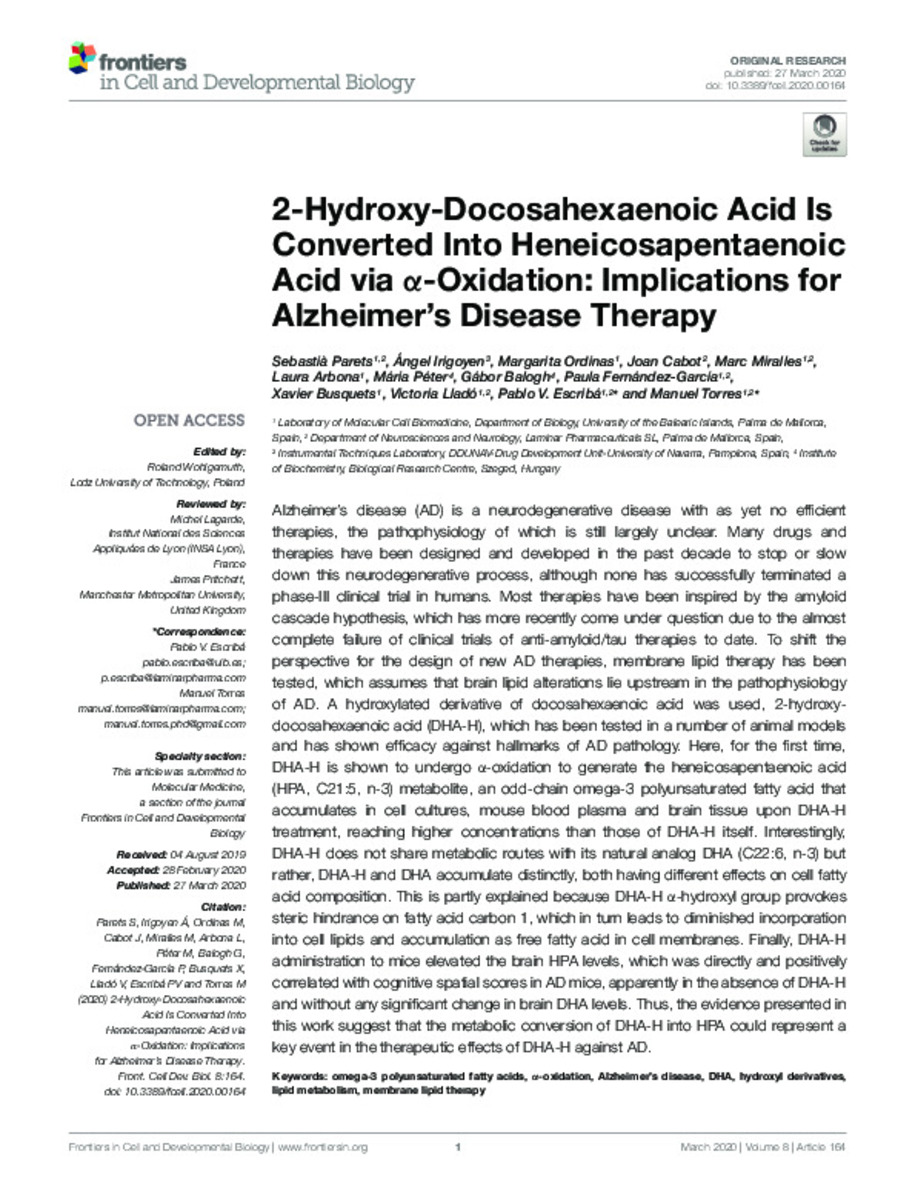Full metadata record
| DC Field | Value | Language |
|---|---|---|
| dc.creator | Parets, S. (Sebastià) | - |
| dc.creator | Irigoyen, A. (Angel) | - |
| dc.creator | Ordinas, M. (Margarita) | - |
| dc.creator | Cabot, J. (Joan) | - |
| dc.creator | Miralles, M. (Marc) | - |
| dc.creator | Arbona, L. (Laura) | - |
| dc.creator | Péter, M. (Maria) | - |
| dc.creator | Balogh, G. (Gábor) | - |
| dc.creator | Fernández-García, P. (Paula) | - |
| dc.creator | Busquets, X. (Xavier) | - |
| dc.creator | Lladó, V. (Victoria) | - |
| dc.creator | Escribá, P.V. (Pablo V.) | - |
| dc.creator | Torres, M. (Manuel) | - |
| dc.date.accessioned | 2023-01-30T10:50:04Z | - |
| dc.date.available | 2023-01-30T10:50:04Z | - |
| dc.date.issued | 2020 | - |
| dc.identifier.citation | Parets, S. (Sebastià); Irigoyen, A. (Angel); Ordinas, M. (Margarita); et al. "2-Hydroxy-Docosahexaenoic Acid Is Converted Into Heneicosapentaenoic Acid via α-Oxidation: Implications for Alzheimer’s Disease Therapy". Frontiers in Cell and Developmental Biology. 8 (164), 2020, | es_ES |
| dc.identifier.issn | 2296-634X | - |
| dc.identifier.uri | https://hdl.handle.net/10171/65193 | - |
| dc.description.abstract | Alzheimer’s disease (AD) is a neurodegenerative disease with as yet no efficient therapies, the pathophysiology of which is still largely unclear. Many drugs and therapies have been designed and developed in the past decade to stop or slow down this neurodegenerative process, although none has successfully terminated a phase-III clinical trial in humans. Most therapies have been inspired by the amyloid cascade hypothesis, which has more recently come under question due to the almost complete failure of clinical trials of anti-amyloid/tau therapies to date. To shift the perspective for the design of new AD therapies, membrane lipid therapy has been tested, which assumes that brain lipid alterations lie upstream in the pathophysiology of AD. A hydroxylated derivative of docosahexaenoic acid was used, 2-hydroxydocosahexaenoic acid (DHA-H), which has been tested in a number of animal models and has shown efficacy against hallmarks of AD pathology. Here, for the first time, DHA-H is shown to undergo α-oxidation to generate the heneicosapentaenoic acid (HPA, C21:5, n-3) metabolite, an odd-chain omega-3 polyunsaturated fatty acid that accumulates in cell cultures, mouse blood plasma and brain tissue upon DHA-H treatment, reaching higher concentrations than those of DHA-H itself. Interestingly, DHA-H does not share metabolic routes with its natural analog DHA (C22:6, n-3) but rather, DHA-H and DHA accumulate distinctly, both having different effects on cell fatty acid composition. This is partly explained because DHA-H α-hydroxyl group provokes steric hindrance on fatty acid carbon 1, which in turn leads to diminished incorporation into cell lipids and accumulation as free fatty acid in cell membranes. Finally, DHA-H administration to mice elevated the brain HPA levels, which was directly and positively correlated with cognitive spatial scores in AD mice, apparently in the absence of DHA-H and without any significant change in brain DHA levels. Thus, the evidence presented in this work suggest that the metabolic conversion of DHA-H into HPA could represent a key event in the therapeutic effects of DHA-H against AD. | es_ES |
| dc.description.sponsorship | This work was supported by the Spanish Ministerio de Economía y Competitividad and Agencia Estatal de Investigación (AEI) (Grants RTC-2015-3542 and RTC-2015-4094, supported by FEDER funds), by the Marathon Foundation and by the Govern de les Illes Balears i del Fons Social Europeu (Grants PROCOE/5/2017, ES01/TCAI/53_2016, ES01/TCAI/21_2017, ES01/TCAI/24_2018). This work was also supported in part by the European Commission (H2020 Framework Programme; Project CLINGLIO 755179) and by the Ministry for Hungarian National Economy (GINOP-2.3.2-15-2016-00060). VL was recipient of a Torres-Quevedo research contract from the Spanish Ministerio de Economía y Competitividad and the European Social Fund “Investing in your future” (grant reference: PTQ-17-09056). SP and MM were supported by a Research Contracts from the Conselleria d’Innovació, Recerca i Turisme del Govern de les Illes Balears i del Fons Social Europeu ("Inverteix en el teu futur" program): Grants FPI/2063/2017 to SP and FPI/2177/2018 to MM. | es_ES |
| dc.language.iso | eng | es_ES |
| dc.publisher | Frontiers in Cell and Developmental Biology | es_ES |
| dc.relation | RTC-2015-3542 | es_ES |
| dc.relation | RTC-2015-4094 | es_ES |
| dc.relation | PROCOE/5/2017 | es_ES |
| dc.relation | ES01/TCAI/53_2016 | es_ES |
| dc.relation | ES01/TCAI/21_2017 | es_ES |
| dc.relation | ES01/TCAI/24_2018 | es_ES |
| dc.relation | CLINGLIO 755179 | es_ES |
| dc.relation | PTQ-17-09056 | es_ES |
| dc.rights | info:eu-repo/semantics/openAccess | es_ES |
| dc.subject | Omega-3 polyunsaturated fatty acids | es_ES |
| dc.subject | α-oxidation | es_ES |
| dc.subject | Alzheimer’s disease | es_ES |
| dc.subject | DHA | es_ES |
| dc.subject | Hydroxyl derivatives | es_ES |
| dc.subject | Lipid metabolism | es_ES |
| dc.subject | Membrane lipid therapy | es_ES |
| dc.title | 2-Hydroxy-Docosahexaenoic Acid Is Converted Into Heneicosapentaenoic Acid via α-Oxidation: Implications for Alzheimer’s Disease Therapy | es_ES |
| dc.type | info:eu-repo/semantics/article | es_ES |
| dc.description.note | This is an open-access article distributed under the terms of the Creative Commons Attribution License (CC BY). | es_ES |
| dc.identifier.doi | 10.3389/fcell.2020.00164 | - |
| dadun.citation.number | 164 | es_ES |
| dadun.citation.publicationName | Frontiers in Cell and Developmental Biology | es_ES |
| dadun.citation.volume | 8 | es_ES |
| dc.identifier.pmid | 32292781 | - |
Files in This Item:
Statistics and impact
Items in Dadun are protected by copyright, with all rights reserved, unless otherwise indicated.






